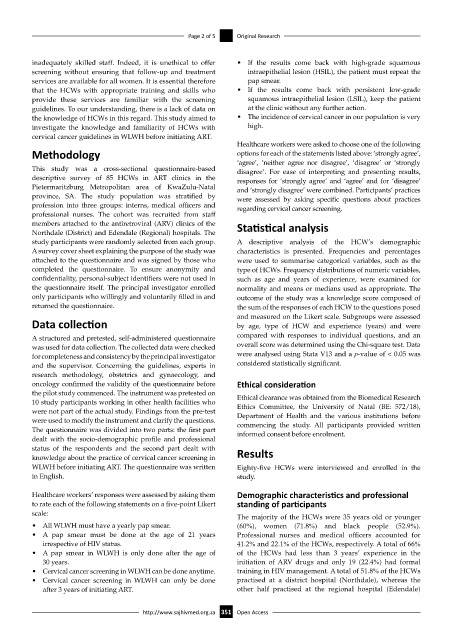Page 359 - HIVMED_v21_i1.indb
P. 359
Page 2 of 5 Original Research
inadequately skilled staff. Indeed, it is unethical to offer • If the results come back with high-grade squamous
screening without ensuring that follow-up and treatment intraepithelial lesion (HSIL), the patient must repeat the
services are available for all women. It is essential therefore pap smear.
that the HCWs with appropriate training and skills who • If the results come back with persistent low-grade
provide these services are familiar with the screening squamous intraepithelial lesion (LSIL), keep the patient
guidelines. To our understanding, there is a lack of data on at the clinic without any further action.
the knowledge of HCWs in this regard. This study aimed to • The incidence of cervical cancer in our population is very
investigate the knowledge and familiarity of HCWs with high.
cervical cancer guidelines in WLWH before initiating ART.
Healthcare workers were asked to choose one of the following
Methodology options for each of the statements listed above: ‘strongly agree’,
‘agree’, ‘neither agree nor disagree’, ‘disagree’ or ‘strongly
This study was a cross-sectional questionnaire-based disagree’. For ease of interpreting and presenting results,
descriptive survey of 85 HCWs in ART clinics in the responses for ‘strongly agree’ and ‘agree’ and for ‘disagree’
Pietermaritzburg Metropolitan area of KwaZulu-Natal and ‘strongly disagree’ were combined. Participants’ practices
province, SA. The study population was stratified by were assessed by asking specific questions about practices
profession into three groups: interns, medical officers and regarding cervical cancer screening.
professional nurses. The cohort was recruited from staff
members attached to the antiretroviral (ARV) clinics of the Statistical analysis
Northdale (District) and Edendale (Regional) hospitals. The
study participants were randomly selected from each group. A descriptive analysis of the HCW’s demographic
A survey cover sheet explaining the purpose of the study was characteristics is presented. Frequencies and percentages
attached to the questionnaire and was signed by those who were used to summarise categorical variables, such as the
completed the questionnaire. To ensure anonymity and type of HCWs. Frequency distributions of numeric variables,
confidentiality, personal-subject identifiers were not used in such as age and years of experience, were examined for
the questionnaire itself. The principal investigator enrolled normality and means or medians used as appropriate. The
only participants who willingly and voluntarily filled in and outcome of the study was a knowledge score composed of
returned the questionnaire. the sum of the responses of each HCW to the questions posed
and measured on the Likert scale. Subgroups were assessed
Data collection by age, type of HCW and experience (years) and were
A structured and pretested, self-administered questionnaire compared with responses to individual questions, and an
was used for data collection. The collected data were checked overall score was determined using the Chi-square test. Data
for completeness and consistency by the principal investigator were analysed using Stata V13 and a p-value of < 0.05 was
and the supervisor. Concerning the guidelines, experts in considered statistically significant.
research methodology, obstetrics and gynaecology, and
oncology confirmed the validity of the questionnaire before Ethical consideration
the pilot study commenced. The instrument was pretested on Ethical clearance was obtained from the Biomedical Research
10 study participants working in other health facilities who Ethics Committee, the University of Natal (BE: 572/18),
were not part of the actual study. Findings from the pre-test Department of Health and the various institutions before
were used to modify the instrument and clarify the questions. commencing the study. All participants provided written
The questionnaire was divided into two parts: the first part informed consent before enrolment.
dealt with the socio-demographic profile and professional
status of the respondents and the second part dealt with Results
knowledge about the practice of cervical cancer screening in
WLWH before initiating ART. The questionnaire was written Eighty-five HCWs were interviewed and enrolled in the
in English. study.
Healthcare workers’ responses were assessed by asking them Demographic characteristics and professional
to rate each of the following statements on a five-point Likert standing of participants
scale:
The majority of the HCWs were 35 years old or younger
• All WLWH must have a yearly pap smear. (60%), women (71.8%) and black people (52.9%).
• A pap smear must be done at the age of 21 years Professional nurses and medical officers accounted for
irrespective of HIV status. 41.2% and 22.1% of the HCWs, respectively. A total of 66%
• A pap smear in WLWH is only done after the age of of the HCWs had less than 3 years’ experience in the
30 years. initiation of ARV drugs and only 19 (22.4%) had formal
• Cervical cancer screening in WLWH can be done anytime. training in HIV management. A total of 51.8% of the HCWs
• Cervical cancer screening in WLWH can only be done practised at a district hospital (Northdale), whereas the
after 3 years of initiating ART. other half practised at the regional hospital (Edendale)
http://www.sajhivmed.org.za 351 Open Access

